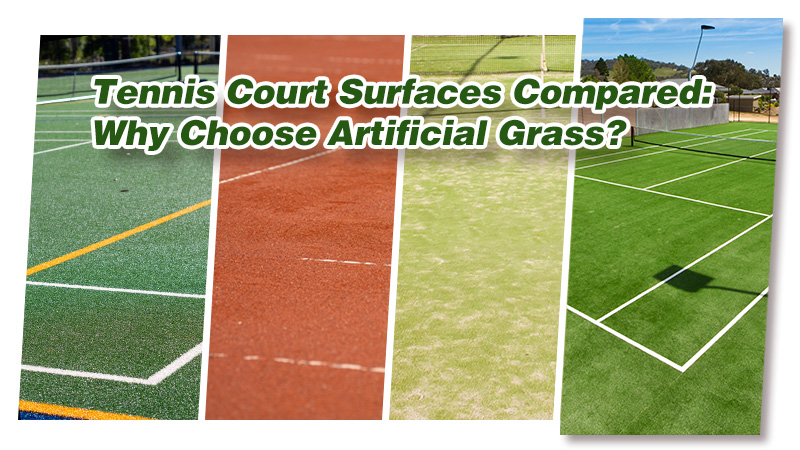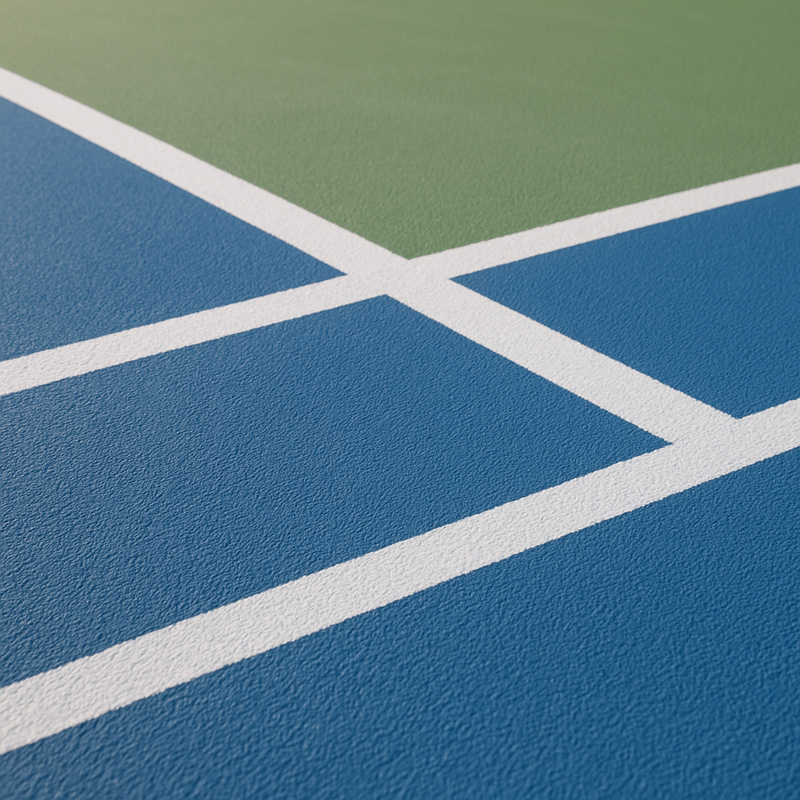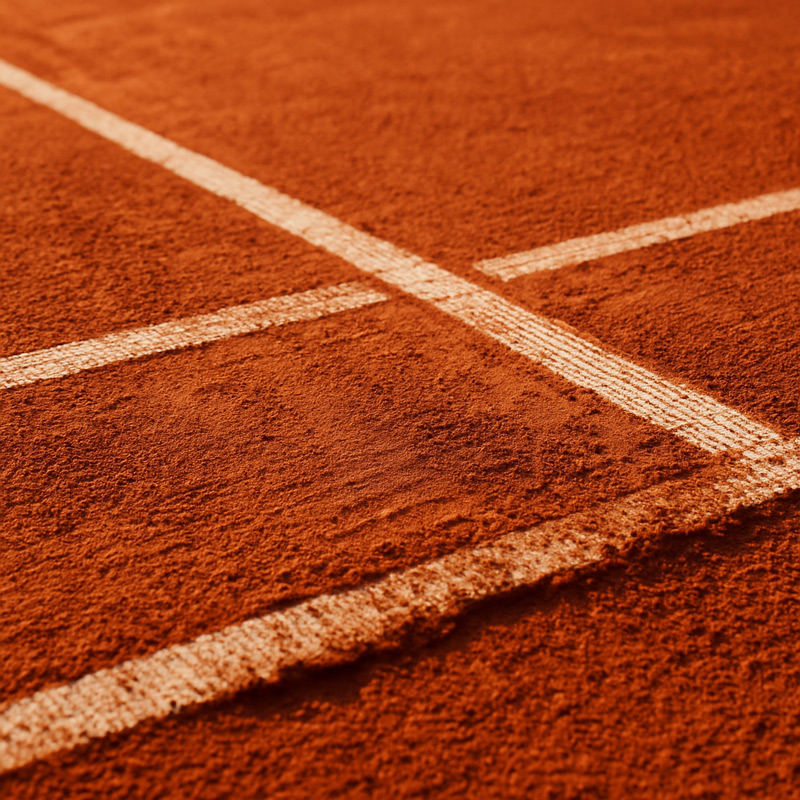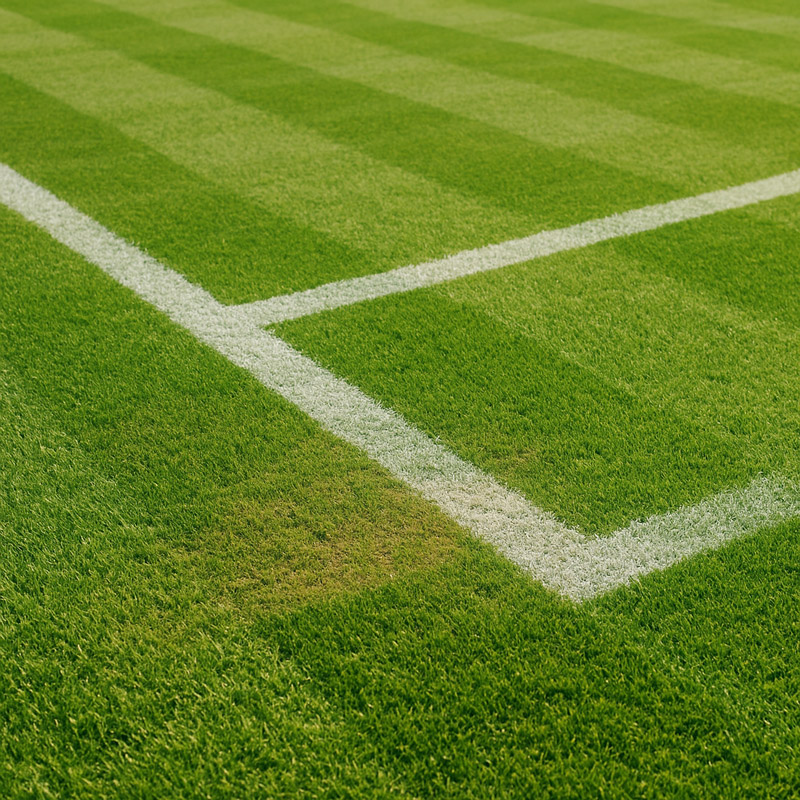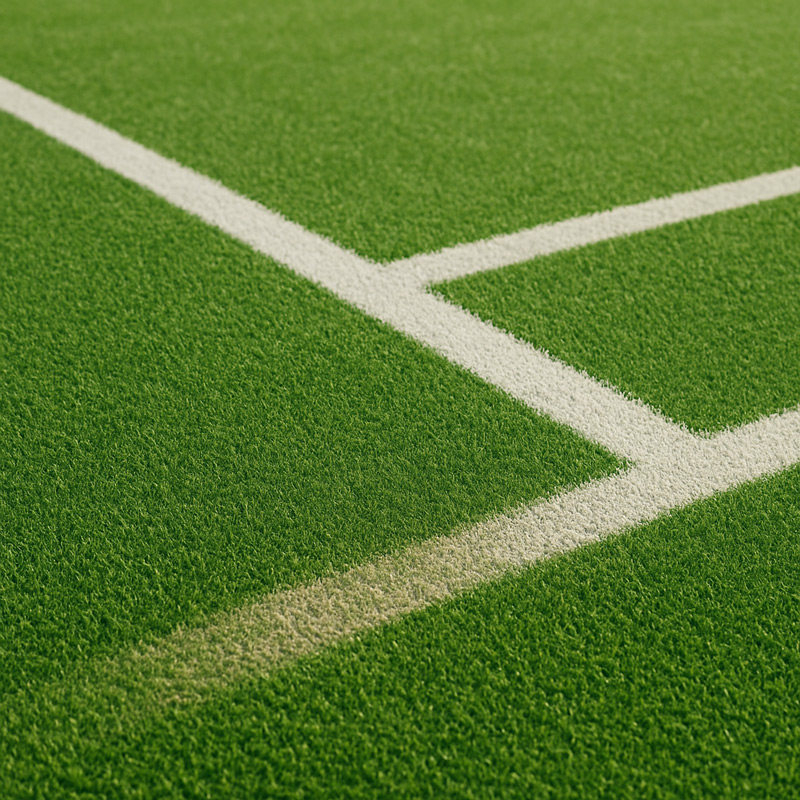Tennis Court Surfaces Compared: Why Choose Artificial Grass?
- 06/24/2025
Tennis courts come in a variety of surfaces, each offering unique playing experiences, maintenance requirements, and aesthetic appeal. Whether you’re a beginner learning the basics, an advanced player refining your skills, or a facility owner building or upgrading a court, understanding these options is key to making an informed choice.
This guide explores the main types of tennis courts—acrylic hard, clay, natural grass, and artificial turf—highlighting why artificial grass tennis courts stand out. We’ll also introduce premium tennis turf products and cover common questions to help you find the right surface for your game.
In this article:
- Understand 4 main types of tennis court surfaces
- Quick comparison of different types of tennis court surfaces
- Recommended tennis turf products
- Frequently asked questions about artificial turf tennis courts
- What is the recommended area for a tennis court?
- How to build a synthetic grass tennis court?
- How do you maintain an artificial turf court?
- Are there pro tournaments on artificial grass courts (with sand)?
- How to choose the right artificial grass tennis shoes?
- Are tennis and pickleball courts the same?
- What is the downside of artificial turf?
- Conclusion
Understand 4 main types of tennis court surfaces
Acrylic hard tennis courts
Description:
Constructed from asphalt or concrete coated with an acrylic topcoat, these courts are renowned for their durability and are a staple in professional tournaments like the US Open and Australian Open. Their smooth, uniform surface ensures reliable performance across diverse playing conditions.
Playability:
Acrylic hard courts deliver a consistent and predictable ball bounce, making them ideal for diverse playing styles—baseline grinders can dig in for long rallies, while serve-and-volley players capitalize on quick points. With a medium to fast pace, they suit professional and recreational play alike.
However, the rigid surface offers limited shock absorption, which can strain joints and lead to discomfort or injuries, especially during extended play. Players with knee or ankle concerns may need extra precautions.
Durability:
Built to last, these courts resist weather damage and handle heavy foot traffic well, making them a reliable choice for public facilities, clubs, and schools. With proper care, an acrylic hard court can remain functional for many years, offering excellent value over time.
Upkeep:
Maintenance is minimal and straightforward. Regular sweeping clears debris, and resurfacing every 5–7 years keeps the court in top shape. The surface dries quickly after rain, ensuring more playable days than weather-sensitive alternatives. Small cracks may need patching, but overall, upkeep demands are low.
Visual appeal:
With a sleek, modern finish and customizable colors—vibrant blues, greens, or classic grays—acrylic hard courts enhance any facility’s look. The smooth surface ensures sharp, visible court lines, improving both aesthetics and gameplay clarity.
Who it’s for:
Ideal for beginners mastering basics due to the reliable bounce, as well as intermediate and advanced players who blend speed and power for dynamic matches.
Clay tennis courts
Description:
Made from natural crushed brick or stone, typically in red or green hues, clay courts are iconic in tournaments like the French Open. Their loose, granular surface creates a unique playing experience that emphasizes strategy and endurance.
Playability:
Clay courts offer a slower pace that extends rallies and rewards strategic, defensive play. The softer surface is kinder to joints, reducing fatigue and making it a go-to for players with physical limitations.
The ability to slide into shots adds a skill layer—think Rafael Nadal dominating the French Open. However, the slower speed may frustrate power players who thrive on quick exchanges.
Durability:
Clay courts can endure for years, but their lifespan depends on consistent care. The loose surface wears unevenly without regular attention, especially in busy areas like the baseline. When maintained well, they provide a resilient playing field that withstands frequent use.
Upkeep:
Expect high maintenance demands. Daily brushing and watering are essential to keep the surface even and playable, while periodic rolling and resurfacing prevent deterioration. Clay is weather-sensitive—rain makes it soggy and unplayable, while dry conditions kick up dust. Players in wet climates may face frequent downtime.
Visual appeal:
The iconic red or green tones of clay courts bring a classic, earthy charm. Their natural, textured surface exudes a timeless elegance, especially when freshly groomed, making them a standout feature for any tennis facility.
Who it’s for:
Best for intermediate players building endurance and defensive skills, and advanced athletes who excel with fitness and precision on this demanding surface.
Natural grass tennis courts
Description:
Composed of natural grass, often specialized varieties like ryegrass, grown over a soil base, grass courts offer a soft, non-reflective surface that’s comfortable underfoot, as seen at Wimbledon. Their organic texture evokes tennis’s historic charm, appealing to purists and traditionalists.
Playability:
Grass courts deliver a fast, low-bouncing surface, ideal for serve-and-volley players who capitalize on quick net exchanges. The soft grass cushions joints, enhancing comfort during dynamic play.
However, the slippery texture and rapid pace challenge beginners, requiring sharp reflexes and precise footwork to control the game’s rhythm.
Durability:
As a natural surface, grass has a shorter lifespan than synthetic options. It wears down with heavy use and weather exposure, often requiring rest periods to regrow. With diligent care, it can last several seasons, but it’s inherently less durable than hard or artificial courts.
Upkeep:
Maintenance is intensive and costly. Regular mowing, watering, and protection from rain or drought are non-negotiable. The effort rivals tending a pristine lawn, making grass courts a premium, high-commitment choice reserved for those who prioritize tradition over convenience.
Visual appeal:
Nothing matches the lush, green elegance of a well-kept natural grass court. Its vibrant, natural beauty evokes tennis’s golden age, turning any facility into a picturesque haven for players and onlookers.
Who it’s for:
Tough for beginners due to its speed and slipperiness, but intermediate players adapt with practice, and advanced serve-and-volley stars shine on this classic surface.
Artificial grass tennis courts
Description:
Made of synthetic fibers designed to emulate natural grass, artificial turf courts are stabilized with sand infill for consistent performance. As a modern, versatile solution, they combine the natural grass feel with superior durability and minimal maintenance, making them an exceptional choice for new installations or resurfacing projects for clubs, schools, or private homes.
Playability:
Artificial turf blends the natural feel with synthetic consistency, offering customizable court speed with reliable bounce and spin—ideal for baseliners, net players, and all-rounders of all skill levels.
The cushioned surface provides a softer landing, easing joint strain and lowering injury risk. Its stable footing supports both intense training and relaxed matches. Advanced systems allow customization of pile height and infill levels to fine-tune pace and bounce, tailoring the court to specific needs, whether for recreational or tournament play.
Durability:
Engineered for endurance, synthetic turf withstands heavy use and harsh weather thanks to durable synthetic fibers and robust infill systems. A well-installed court, with a quality sub-base, delivers years of high-quality performance, rivaling acrylic in resilience while offering added comfort. Its UV-resistant materials ensure it remains functional and vibrant for 8–10 years or more with proper care.
Upkeep:
Maintenance is low and manageable. Periodic brushing and sweeping keep fibers upright and remove debris like leaves or dust, while infill leveling maintains an even playing surface. The weather-resistant turf dries quickly after rain, allowing for near year-round play—unlike clay or grass courts.
Occasional deep cleaning rejuvenates the court, but routine care is minimal compared to natural surfaces, making it ideal for busy facilities or homeowners seeking convenience.
Visual appeal:
Classic green surfaces with white lines deliver a timeless, clean aesthetic. Bright, customizable color schemes—such as terracotta or blue playing areas with green surrounds—enhance modern appeal, simplify line calls, and improve gameplay. Whether in public parks or private estates, these visual advantages add both functionality and long-term value.
Multi-sport adaptability:
Unlike traditional surfaces, artificial turf supports additional sports like hockey, pickleball, or recreational sports, making it a versatile investment for schools, community centers, or multi-use venues.
Who it’s for:
Perfect for beginners seeking a safe, stable start, intermediate players honing tactics, and advanced players using it for practice or casual exhibition matches. Its versatility and comfort make it a top choice for diverse settings.
Quick comparison of different types of tennis court surfaces
To help you compare tennis court surfaces at a glance, we’ve created this tennis court surface comparison chart. It highlights key differences in cost, maintenance, playability, and customization, making it easier to choose the best surface for your needs.
| Aspect | Acrylic Court | Clay Court | Natural Grass | Artificial Grass |
| Cost & Maintenance | ||||
| Installation Cost | Medium-High | Medium | Low | Low-Medium |
| Installation Ease | Easy | Medium | Hard | Medium |
| Maintenance Effort | Low | High | High | Medium |
| Lifespan | Long | Short | Medium | Long |
| Player Experience | ||||
| Joint Protection | Medium | Medium | Very High | High |
| Play Speed | Medium-Fast | Slow | Fast | Medium-Fast |
| Ball Bounce | High | Medium | Unpredictable | Consistent |
| Sliding Ease | Limited | Easy | Easy | Moderate |
| Skill Suitability | All levels | Skilled players | Skilled players | All levels |
| Environmental Factors | ||||
| Usability | All-year | Seasonal | Seasonal | All-year |
| Weather Impact | Minimal | High (Rain-sensitive) | High | Minimal |
| Drainage Efficiency | High | Medium (Varies by type) | Medium | High |
| Surface Temperature | Hot in sun | Medium | Coolest | Medium |
| Customization & Functionality | ||||
| Color Options | Yes | Limited | None | Wide variety |
| Lines & Markings | Permanent | Frequent repainting | Frequent repainting | Easy to customize |
| Multi-Sport Compatibility | Yes | No | No | Yes |
| Indoor/Outdoor Use | Both | Outdoor only | Outdoor only | Both |
Recommended tennis turf products
When selecting synthetic grass for your tennis court, it’s essential to consider the unique needs of your facility and the advantages that different turf systems provide.
What is the classification of ITF court pace?
The International Tennis Federation (ITF) classifies court surfaces into five pace categories:
Category 1 (Slow): Courts that slow down the ball for longer rallies
Category 2 (Medium-slow): Slightly slower than average pace
Category 3 (Medium): Balanced speed for all playing styles
Category 4 (Medium-fast): Faster pace supporting aggressive play
Category 5 (Fast): Very fast courts favoring quick exchanges and serve-and-volley play
CCGrass delivers premium tennis turf solutions designed for varying playing speeds, supporting everything from casual matches to advanced training.
YEII Series
- Unique fibrillating structure
- Excellent playing performance
- High wear resistance
- Fast-paced court, certified ITF Category 5 (Fast)
- Also suitable for padel and recreational multi-sport use
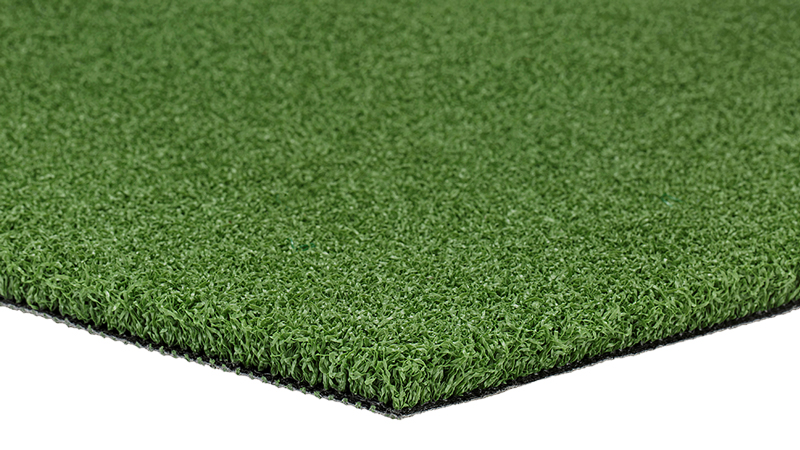
FastPro HF Series
- Dense, texturised monofilament
- True tennis performance
- Excellent durability
- Medium to fast-paced court
- Versatile for hockey, padel, and putting green applications
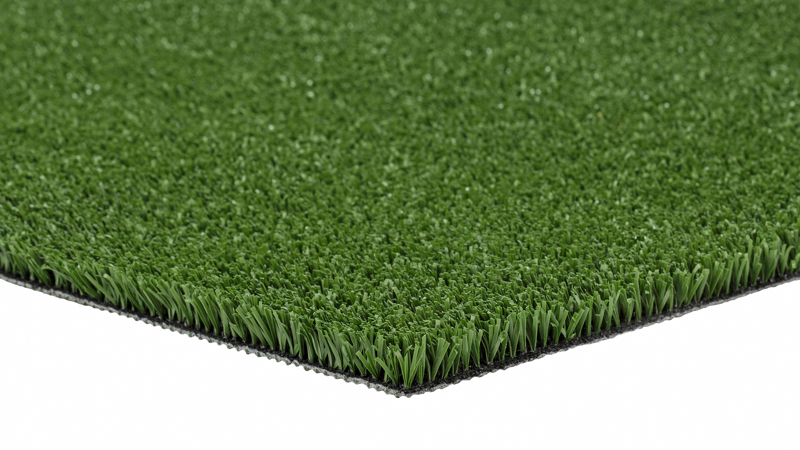
Nature D3 Series
- Dense monofilament fibre
- Excellent playing performance
- Natural grass appearance
- Medium-paced court
- Also suitable for recreational sports use
Ideal scenarios for artificial grass tennis courts
Artificial turf tennis courts are an excellent fit for diverse applications:
- School and university campuses: Ideal for multi-sport activities and student recreation.
- Professional sports clubs: Designed for consistent performance and high-level play.
- Parks and recreation centers: Durable and easy-to-maintain courts for public use.
- Commercial sports facilities: Reliable surfaces for games, tournaments, or daily use.
- Residential communities: Transform shared spaces into functional and attractive courts.
- Urban rooftop courts: Maximise underused spaces with all-weather courts.
- Private homes: A practical and stylish option for backyard courts.
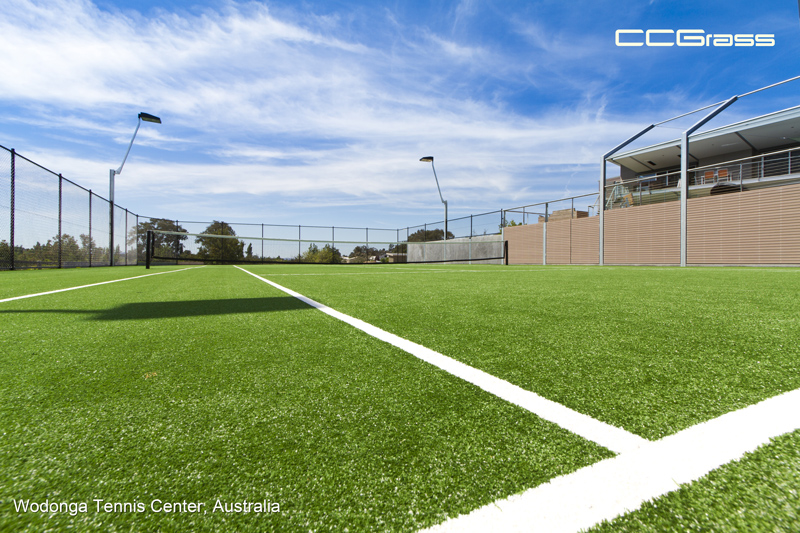
Frequently asked questions about artificial turf tennis courts
What is the recommended area for a tennis court?
A standard tennis court measures 78 x 36 feet (2,808 sq ft) for doubles play, but a total area of 120 x 60 feet (7,200 sq ft) is recommended to include safety zones, fencing, and player run-off space.
How to build a synthetic grass tennis court?
Building a synthetic grass tennis court starts with a stable sub-base (asphalt or concrete), followed by installing shock-absorbing underlay, laying artificial turf, and adding sand infill for stability. Professional contractors ensure proper drainage and ITF-compliant dimensions. Contact CCGrass for expert installation guidance.
How do you maintain an artificial turf court?
Regularly sweep debris with a soft-bristled broom, brush fibers weekly to keep them upright, and level infill monthly using a drag brush. Inspect seams annually for wear. Use mild detergent for stains. Schedule professional deep cleaning once or twice a year to ensure optimal surface condition.
Are there pro tournaments on artificial grass courts (with sand)?
Professional tennis tournaments rarely use sand-filled artificial grass tennis courts, favoring hard, clay, or natural grass surfaces. Some regional or club-level events may feature them. Our customizable tennis turf meets high-performance standards, ideal for competitive play.
How to choose the right artificial grass tennis shoes?
Choose tennis shoes with non-marking soles and small rubber nubs or a herringbone pattern for good grip without damaging the turf. Good cushioning and side support help reduce joint strain.
Are tennis and pickleball courts the same?
Tennis courts (78 x 36 feet) are larger than pickleball courts (44 x 20 feet). Synthetic turf supports both, with adjustable net heights and temporary pickleball lines, enabling easy transitions for shared facilities.
What is the downside of artificial turf?
Artificial turf may retain heat in hot climates, requiring cooling measures. Initial installation costs can be high, though long-term savings offset this. Rare seam wear may need repairs, but high-quality turf reduces these issues.
Conclusion
Your ideal tennis court starts with the right surface. Traditional options each have their strengths, but artificial grass tennis courts go above and beyond with superior comfort, adaptability, and durability. Whether for recreational play, professional training, or multi-sport facilities, artificial turf is a smart investment that combines performance with lasting value. Contact us for free samples and quotes at 86 25 6981 1666 or email us at [email protected] today!



